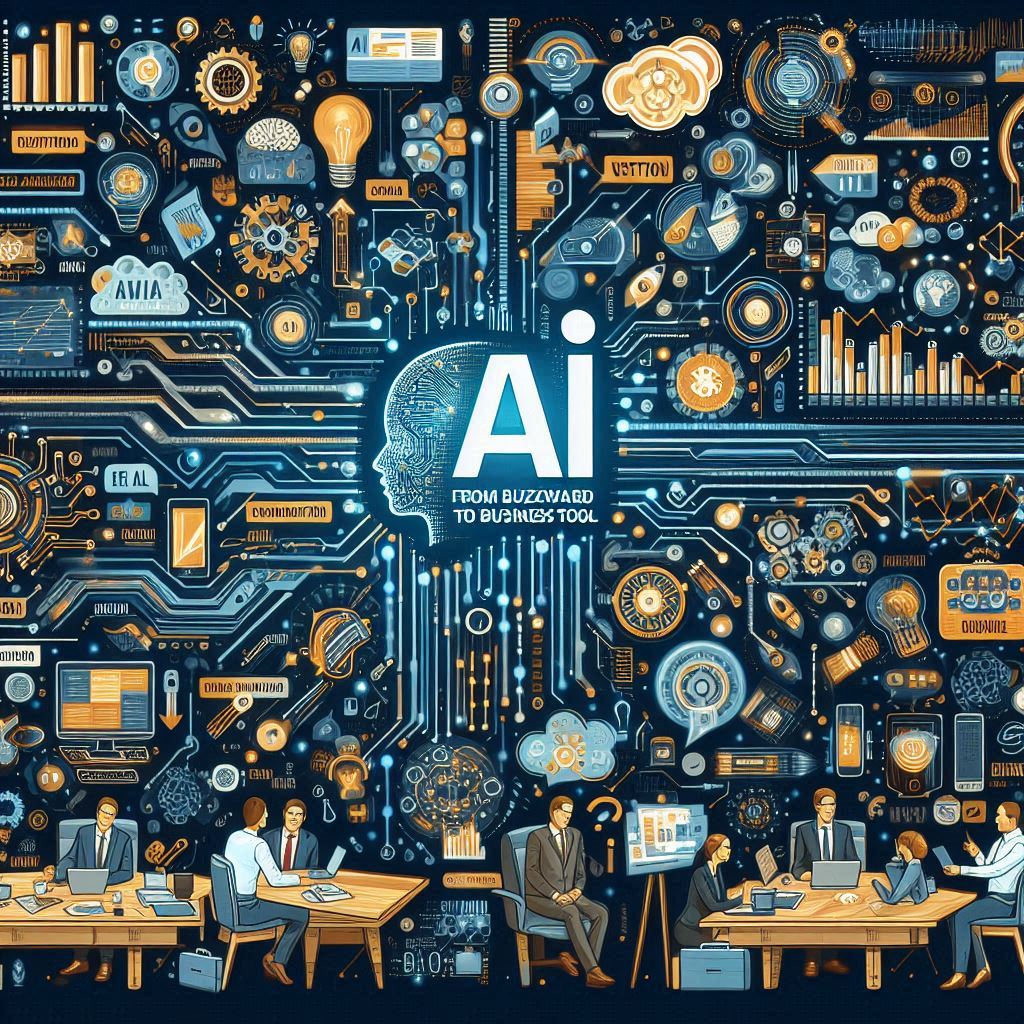From Buzzword to Business Tool: How Organisations are Embracing AI
For years, artificial intelligence (AI) has been a constant presence in business discussions. Conferences buzzed with presentations on its potential, news articles touted its revolutionary capabilities, and executives pondered its future impact. However, for many white-collar workers, AI remained a distant concept – something for the distant future.
The landscape is rapidly changing. Businesses are no longer just talking about AI; they are actively integrating it into their operations. This shift from theoretical discussions to practical implementation is transforming the workplace, particularly for the white-collar workforce.
This article explores how organisations are moving from AI talk to AI adoption. We’ll delve into the key drivers, explore real-world examples across various industries, and discuss the challenges and opportunities this transition presents for white-collar professionals.
Why Now? The Rise of AI Adoption
Several factors are propelling the rise of AI adoption:
Technological Advancements: Advances in AI technology have made it more accessible and affordable for businesses of all sizes (Manyika et al., 2017). Cloud computing services like Amazon Web Services (AWS) offer readily deployable AI solutions, eliminating the need for massive in-house infrastructure investments (Manyika et al., 2017).
Data Deluge: Organisations are now swimming in data generated from various sources, including customer interactions, social media, and internet-connected devices (Manyika et al., 2017). This data serves as the fuel for AI algorithms, allowing them to identify patterns, make predictions, and automate tasks.
Demonstrated ROI: Early adopters of AI have showcased significant returns on investment (ROI), encouraging others to follow suit (Agrawal et al., 2020). For example, General Electric (GE) utilised AI to predict equipment failures in aviation, leading to reduced downtime and maintenance costs (GE Healthcare, 2023). Such success stories illustrate the tangible benefits of AI adoption.
AI in Action: Transforming Industries
AI adoption is no longer confined to futuristic pronouncements. It’s transforming real-world operations across various industries:
Financial Services: Banks and financial institutions are leveraging AI for fraud detection, risk management, and customer service. For instance, JPMorgan Chase’s COiN platform uses AI to analyse legal documents, expediting the process and minimising errors (JPMorgan Chase & Co., 2023).
Healthcare: AI is revolutionising diagnostics and treatment. IBM’s Watson Health analyses vast amounts of medical data to provide insights for treatment plans, while hospitals use AI to manage patient flow and even assist surgeons with robotic tools (IBM, 2023).
Retail: AI is enhancing customer experiences and optimising supply chains. Retail giants like Amazon use AI for recommendation engines, while others leverage AI-powered inventory management systems to predict stock requirements and avoid stockouts (Manyika et al., 2017).
Human Resources: AI is transforming recruitment and employee management. LinkedIn utilises AI to match job seekers with potential employers, while HireVue employs AI-powered video interviewing platforms, streamlining the hiring process (Forbes., 2023).
These are just a few examples, and the potential applications of AI extend far beyond these sectors. As AI continues to evolve, we can expect even more innovative applications across the white-collar work spectrum.
Challenges and Opportunities for the Workforce
While AI adoption offers exciting possibilities, it also presents challenges for the workforce:
Skill Gaps: There’s a significant skills gap regarding AI technologies. To effectively implement AI, employees may need to develop skills in understanding core AI concepts, specific AI applications relevant to their roles, and critical thinking abilities to evaluate AI outputs (World Economic Forum, 2020).
Integration Issues: Integrating AI into existing systems can be complex. Legacy systems may not be compatible, necessitating infrastructure upgrades (Accenture, 2020). Companies may need to carefully plan phased implementations to ensure a smooth transition.
Job displacement concerns: Some workers fear AI automation might replace their jobs. While automation is likely to impact some tasks, research suggests a more nuanced picture. AI will likely displace repetitive tasks, but it will also create new opportunities requiring human creativity and problem-solving skills (Brown et al., 2023).
However, the transition towards AI adoption also presents significant opportunities for white-collar professionals:
Enhanced Productivity: AI can automate mundane tasks, freeing up valuable time for white-collar workers to focus on higher-level cognitive work, like strategy development and client relationship management.
Improved Decision-Making: AI insights can provide valuable data-driven information for white-collar professionals to make more informed decisions across various aspects of their work.
Increased Innovation: AI can assist in tasks like data analysis and pattern recognition, fostering a more innovative work environment where white-collar professionals can leverage AI’s capabilities to develop new ideas and solutions (Chui, Manyika & Osborne, 2018).
Career Growth: As AI becomes more integrated into workplaces, professionals who possess skills in areas like AI literacy, data analysis, and human-computer interaction will be highly sought-after (Brown et al., 2023).
Preparing for the Future: Embracing Change
The rise of AI signifies a significant shift in the white-collar work landscape. Here are some strategies for white-collar professionals to navigate this transition:
Embrace Lifelong Learning: Develop a growth mindset and commit to continuous learning. Explore online courses, attend workshops, or pursue certifications related to AI and its applications within your field (Massachusetts Institute of Technology, 2023).
Identify AI Skills for your Role: Research the potential applications of AI in your specific industry and identify the AI skills most relevant to your work. Focus on developing proficiency in these areas.
Communicate with your Manager: Discuss your interest in AI and how you can contribute to its implementation within your team. Collaborate with your manager to identify opportunities for upskilling and professional development in the context of AI.
Adapt and Innovate: Be open to new ways of working and embrace the potential of AI to augment your abilities. Look for opportunities to leverage AI to enhance your workflow and contribute to innovative solutions within your organisation.
The move from AI talk to AI adoption is well underway. As AI becomes more ingrained in workplaces, white-collar professionals have a crucial role to play. By embracing lifelong learning, developing relevant skills, and adapting to new work styles, white-collar workers can leverage AI as a powerful tool to enhance their productivity, decision-making, and career prospects. The future of work is one where humans and AI collaborate to achieve greater efficiency, innovation, and success.
References
- Agrawal, A., Gans, N., & Goldfarb, A. (2020). Prediction machines: The simple economics of artificial intelligence. Harvard Business Review Press.
- Brown, J., Chui, M., & Manyika, J. (2023). AI for the workforce. McKinsey Global Institute. https://www.mckinsey.com/mgi/our-research/generative-ai-and-the-future-of-work-in-america
- Chui, M., Manyika, J., & Osborne, M. (2018). Jobs lost, jobs gained: Workforce transitions in a time of automation. McKinsey Global Institute.
- GE Healthcare. (2023, May 12). How GE healthcare is using AI to transform healthcare. https://www.gehealthcare.com/about/newsroom/press-releases/ge-healthcare-accelerates-ai-innovation-with-healthcare-specific-foundation-models-powered-by-nvidia
- IBM. (2023, June 21). IBM Watson Health. https://www.ibm.com/watson-health/
- JPMorgan Chase & Co. (2023, April 14). Contract intelligence (COIN). https://futurism.com/an-ai-completed-360000-hours-of-finance-work-in-just-seconds
- Manyika, J., Chui, M., & Miremadi, M. (2017). A decade in digital transformation: How artificial intelligence is changing the way companies play. McKinsey Global Institute. [https://www.mckinsey.com/capabilities/mckinsey-digital/our-insights/leadership-and-digital-transformation]
- Siddharath Sharma (June, 2023) Navigating the AI Revoution in HR. Forbes. Navigating The AI Revolution In HR (forbes.com)






